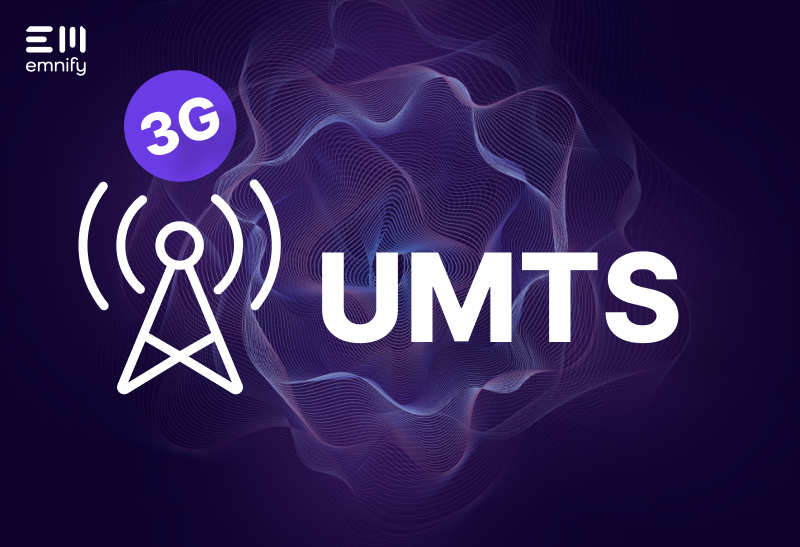

Quick definition: UMTS stands for Universal Mobile Telecommunications Service. It’s the group of radio technologies associated with third-generation (3G) cellular networks. Compared to its predecessors like GSM (Global System for Mobile Communications), UMTS offers greater bandwidth, more efficient use of the radio spectrum, and more advanced cellular capabilities.
UMTS has essentially become synonymous with 3G. Since UMTS uses Code Division Multiple Access (CDMA) technology but has wider bandwidth than other CDMA-based systems (like CDMA2000), it’s also sometimes referred to as wideband CDMA or W-CDMA.
In the years following its initial release, several innovations have increased the data transfer speeds available through UMTS.
Most cellular IoT (Internet of Things) applications around the world rely on 2G or 3G technology like UMTS, so manufacturers need to understand what it’s capable of and whether you should use it for modern applications.
What can you do with UMTS?
UMTS introduced new cellular capabilities like video calling and mobile television. But more importantly, it allows for much higher data transfer rates and uses less power to upload or download data than the older GSM technology.
This increased data transfer rate made UMTS appealing for high-speed Internet connections, but UMTS also uses 50 percent more power than GSM in idle mode, so IoT manufacturers need to consider the potential impact on battery life, too.
Data transfer rates
With any network, IoT manufacturers need to consider the uplink and downlink speeds the technology is capable of. (The uplink speed is the rate at which a device can transmit data, and the downlink speed is the rate at which it can receive data.)
UMTS initially boasted downlink data rates of 384 kilobytes per second (Kbps). That’s 40 times faster than GSM’s 9.6 kbps, and significantly faster than General Packet Radio Service (53.6 Kbps) and even Enhanced Data Rates for GSM Evolution (220 Kbps). Its uplink speed was capped at 128 Kbps. But cellular carriers have improved UMTS data rates with High-Speed Packet Access (HSPA), evolved HSPA (HSPA+), and advanced HSPA+. Advanced HSPA+ enables maximum download speeds of 168 megabits per second (Mbps), and maximum upload speeds of 22 Mbps.
HSPA was intended to bridge the gap between 3G networks and 4G LTE (long term evolution). This allows the network infrastructure to last longer—improving UMTS was more cost efficient than fully converting to LTE—and it was such a vast improvement that HSPA is sometimes referred to as 3.5G.
Packet-switched network vs. circuit-switched network
UMTS relies on a packet-switched system. This allows cellular devices to send small “packets” of data to a destination, whereas circuit-switched networks require a point-to-point connection.
In an old phone network, making a call meant reserving a line between the sender and receiver. With a packet-switched network, devices can just send and receive packets as needed.
It’s sort of like the difference between direct mailing a whole bunch of small, numbered packages through a mail carrier, and sending one big package that requires a dedicated delivery driver. A packet-switched network makes it easier for lots of devices to share bandwidth and transmit and receive large amounts of data.
Should you use UMTS for IoT applications?
While it was once revolutionary, UMTS is nearly two decades old. Two completely new generations of cellular networks have come out since 3G, along with other specialized networks. Some cellular carriers are shifting resources away from UMTS to free bandwidth for these more advanced systems, and a few countries have already begun switching off their 3G networks.
So can you trust UMTS infrastructure to outlast your device? Should you be worried? What are the alternatives? For IoT manufacturers, it comes down to where you plan on deploying and the lifespan of your device.
If your goal is to deploy in a country that only has one cellular carrier (or a couple of them), and they’ve already made plans to switch off their 3G networks, it would be unwise to build a device that relies on 3G. However, most of the world still uses 3G networks.
UMTS has been so popular with IoT manufacturers in the past because it doesn’t require as much power consumption as 4G LTE connectivity and still allows far higher data transfer rates than GSM. But it’s important to remember that this technology wasn’t designed for IoT. Mobile network operators built this infrastructure for cell phones. And cell phones have different connectivity needs than most IoT devices.
Narrowband-IoT (or Nb-IoT) networks and other Low Range Wide Area Networks (LoRaWaNs) were specially designed for machine-to-machine connectivity. And while the industry is constantly evolving, these networks aren’t in danger of being phased out anytime soon.
But at the end of the day, UMTS may still be a perfectly viable option for your application. If you need help exploring your options, and ensuring your devices will have adequate coverage, talk to our cellular IoT experts.
emnify provides complete end-to-end connectivity solutions, and we’d be happy to discuss how we can help you deploy your application anywhere in the world.
Get in touch with our IoT experts
Discover how emnify can help you grow your business and talk to one of our IoT consultants today!

Christian Henke
If you want to understand how emnify customers are using the platform Christian has the insights. With a clear vision to build the most reliable and secure cellular network that can be controlled by IoT businesses Christian is leading the emnify product network team.



